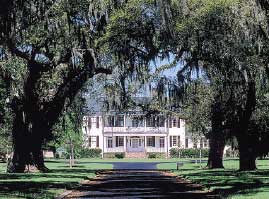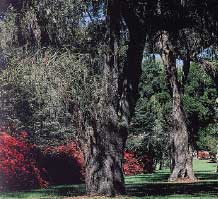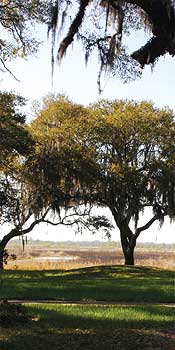Maybe it was just the time of year I visited Pawleys Island’s Litchfield Plantation that  made me feel isolated from the hustle and bustle of everyday life, but it probably has more to do with the careful details they have maintained to guarantee guests a peaceful mood at this historic plantation and country inn.
made me feel isolated from the hustle and bustle of everyday life, but it probably has more to do with the careful details they have maintained to guarantee guests a peaceful mood at this historic plantation and country inn.
Less than a 90-minute drive from Charleston, between Myrtle Beach and Georgetown, Litchfield Plantation offers the historic charm of a former rice plantation with the luxurious comforts of a southern country inn. This 600- acre hideaway on Pawleys Island has a variety of rate packages for weekly stays or overnight visits, with a little something for everyone’s interest — particularly relaxation.
At Litchfield Plantation, guests can prepare for dinner at the Carriage House Club, which provides fine dining and southern cuisine throughout three main dining rooms, a bar, and a lounge area with a working fireplace.
Litchfield Plantation was originally part of a land grant from King George II in 1710 that encompassed thousands of acres from the Atlantic Ocean to the black waters of the Waccamaw River, part of the Intracoastal Waterway. Its most continual antebellum residents were the Tuckers, during the time when South Carolina was the rice-producing capital of the Western World. Current owner Louise Price Parsons inherited the land from her  late grandfather, Julian Price, former president of Jefferson- Pilot Corporation, a major insurance and broadcast holding company. In the 1970s, architectural restoration experts helped Parsons restore the authentic interior woodwork, molding and other details of the Plantation House to its original elegance. Draperies and furniture fabrics were selected to enhance the antique furnishings and colonial ambiance throughout the plantation.
late grandfather, Julian Price, former president of Jefferson- Pilot Corporation, a major insurance and broadcast holding company. In the 1970s, architectural restoration experts helped Parsons restore the authentic interior woodwork, molding and other details of the Plantation House to its original elegance. Draperies and furniture fabrics were selected to enhance the antique furnishings and colonial ambiance throughout the plantation.
You feel it as soon as you enter the grounds, chatting with the gatekeeper as he notes your arrival and points you toward the quarter-mile drive under the avenue of 250-year-old live oak trees that give way to the old Plantation House. The Plantation House circa 1740 is a white-columned antebellum residence that reminds guests of Tara from Gone With the Wind.
You won’t find a stuffy lobby entrance or marble barricade separating you from employees as you check in at the quaint Guest House. Instead, you’ll probably sit across from Diana Malloy, the reservations attendant, whose roles also include daytime operator and concierge. Her smile and enthusiasm are contagious as she hands you two old-fashioned metal keys to use during your stay, one for your room and the other for the beach house located on Pawleys Island.
Should you decide to stay at the Plantation House, you will have your choice of four historically-decorated suites: the Gun Room, the Red Room, the Blue Room, or the Ballroom Suite (also informally known as the Bridal Suite) with access to the private second-floor balcony. Guests also can stay in the plantation’s 25 cottage suites scattered throughout the expansive grounds and enveloped by the natural Lowcountry beauty.
Each Plantation House suite tells a story. The Gun Room is said to be the quarters of former owner and prosperous rice planter Dr. Henry Massingberd Tucker, who inherited the plantation from his father, John Tucker, one of the plantation’s wealthiest owners who had perfected the rice growing methods and was producing  one million pounds of rice on the plantation by 1850. The Red Room combines South Carolina Lowcountry flair with an Oriental flavor, including red accents that were viewed by plantation owners as good luck charms. The Blue Room overlooks the 400-acre rice fields that lead to the Waccamaw River. The Ballroom Suite encompasses over 1,200 square feet of space that was once the site of glamorous balls, located on the second floor of the house to allow for better cross breezes and access to the private balcony.
one million pounds of rice on the plantation by 1850. The Red Room combines South Carolina Lowcountry flair with an Oriental flavor, including red accents that were viewed by plantation owners as good luck charms. The Blue Room overlooks the 400-acre rice fields that lead to the Waccamaw River. The Ballroom Suite encompasses over 1,200 square feet of space that was once the site of glamorous balls, located on the second floor of the house to allow for better cross breezes and access to the private balcony.
Within a ten-minute drive of the plantation is the national historic landmark Brookgreen Gardens, a 6,000-acre outdoor sculpture garden and nature preserve, featuring native plants and animals of the distinctive landscapes of the Lowcountry and more than 900 works spanning the entire period of American sculpture from the early 1800s to the present.
Back at Litchfield Plantation, guests can prepare for dinner at the Carriage House Club, which provides fine dining and southern cuisine throughout three main dining rooms, a bar, and a lounge area with a working fireplace. Built on the original foundation of the plantation’s carriage house, the Carriage House Club complements the Plantation House in the stately style of old brick and slate, with sweeping vistas indigenous to the grand era of the Southern rice plantation. A large brick indigo dryer, originally used to dry indigo for ink production, sits next to the front door of the restaurant. Executive Chef Orobosa Uwagbai is happy to prepare his renowned grouper served over a sauce beurre blanc with lemon zest while Club Manager Carlos Ribiera helps the attentive service staff toss fresh ingredients for tableside salads and desserts.
Meanwhile, a bottle of champagne (complimentary with most packages) has found its way to your room for your nightcap; it’s the perfect ending to an enchanting and indulgent stay at Litchfield Plantation. But just to make sure you leave satisfied, inn guests enjoy a complimentary hot breakfast at the Carriage House Club and depart through the same avenue of oaks that offered a retreat from the world.
For more information about Litchfield Plantation, visit the website at www.LitchfieldPlantation.com or call 843-237-9121.